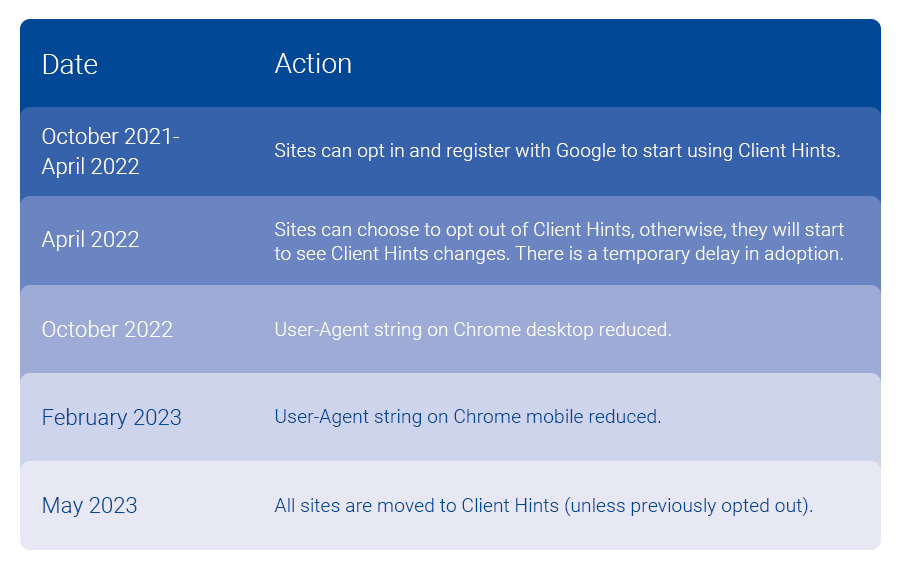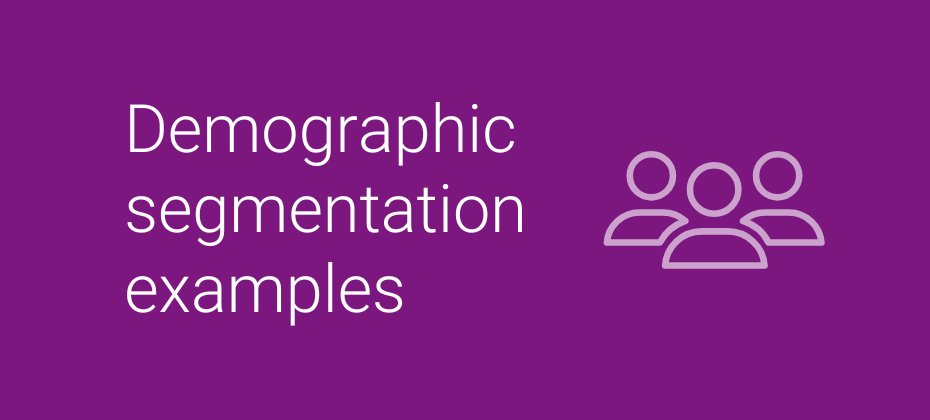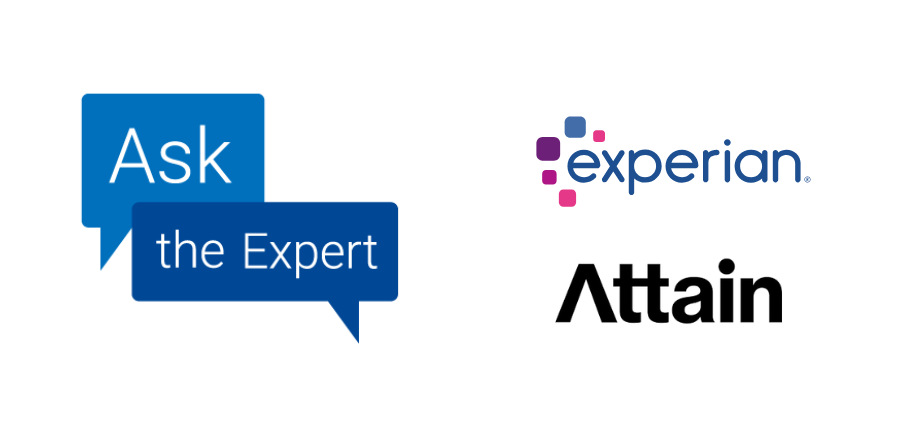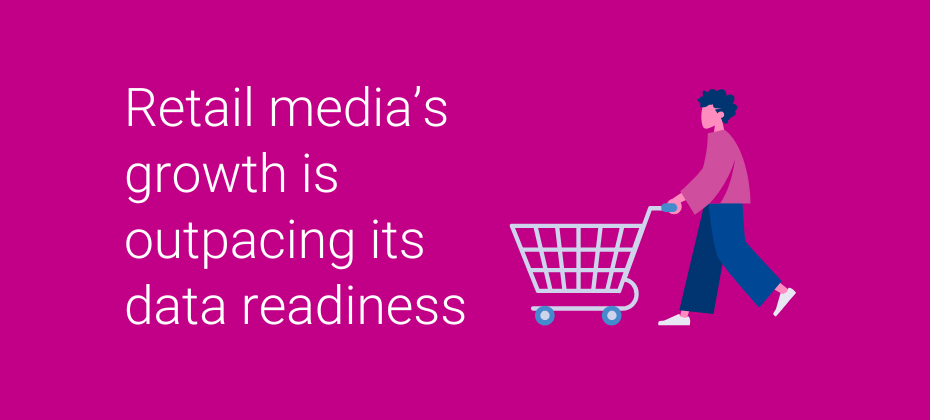In 2022, Google began changing the availability of the information available in User-Agent strings across their Chromium browsers. The change is to use the set of HTTP request header fields called Client Hints. Through this process, a server can request, and if approved by the client, receive information that would have been previously freely available in the User-Agent string. This change is likely to have an impact on publishers across the open web that may use User-Agent information today.
To explain what this change means, how it will impact the AdTech industry, and what you can do to prepare, we spoke with Nate West, our Director of Product.
What is the difference between User-Agents and Client Hints?
A User-Agent (UA) is a string, or line of text, that identifies information about a web server’s browser and operating system. For example, it can indicate if a device is on Safari on a Mac or Chrome on Windows.
Here is an example UA string from a Mac laptop running Chrome:

To limit the passive fingerprinting of users, Google is reducing components of the UA strings in their Chromium browsers and introducing Client Hints. When there is a trusted relationship between first-party domain owners and third-party servers, Client Hints can be used to share the same data.
This transition began in early 2022 with bigger expected changes beginning in February 2023. You can see in the above example, Chrome/109.0.0.0, where browser version information is already no longer available from the UA string on this desktop Chrome browser.
How can you use User-Agent device attributes today?
UA string information can be used for a variety of reasons. It is a component in web servers that has been available for decades. In the AdTech space, it can be used in various ad targeting use cases. It can be used by publishers to better understand their audience. The shift to limit access and information shared is to prevent nefarious usage of the data.
What are the benefits of Client Hints?
By using Client Hints, a domain owner, or publisher, can manage access to data activity that occurs on their web properties. Having that control may be advantageous. The format of the information shared is also cleaner than parsing a string from User-Agents. Although, given that Client Hints are not the norm across all browsers, a long-term solution may be needed to manage UA strings and Client Hints.
An advantage of capturing and sharing Client Hint information is to be prepared and understand if there is any impact to your systems and processes. This will help with the currently planned transition by Google, but also should the full UA string become further restricted.
Who will be impacted by this change?
Publishers across the open web should lean in to understand this change and any potential impact to them. The programmatic ecosystem supporting real-time bidding (RTB) needs to continue pushing for adoption of OpenRTB 2.6, which supports the passing of client hint information in place of data from UA strings.
What is Google’s timeline for implementing Client Hints?

Do businesses have to implement Client Hints? What happens if they don’t?
Not capturing and sharing with trusted partners can impact capabilities in place today. Given Chromium browsers account for a sizable portion of web traffic, the impact will vary for each publisher and tech company in the ecosystem. I would assess how UA strings are in use today, where you may have security concerns or not, and look to get more information on how to maintain data sharing with trusted partners.
We can help you adopt Client Hints
Reach out to our Customer Success team at tapadcustomersuccess@experian.com to explore the best options to handle the User-Agent changes and implement Client Hints. As leaders in the AdTech space, we’re here to help you successfully make this transition. Together we can review the options available to put you and your team on the best path forward.
About our expert

Nate West, Director of Product
Nate West joined Experian in 2022 as the Director of Product for our identity graph. Nate focuses on making sure our partners maintain and grow identity resolution solutions today in an ever-changing future state. He has over a decade of experience working for media organizations and AdTech platforms.
Latest posts

Not all customers are the same, so why waste your budget marketing to them like they are? McKinsey research shows that 71% of consumers want personalized shopping experiences, and 76% get frustrated when they don’t have them. That’s where demographic segmentation comes in. But what is demographic segmentation, exactly? We define it as a process that helps you categorize your audience into meaningful demographic groups so you can reach the right people with impactful custom messages. Businesses across industries are partnering with Experian to power smarter decisions and better results through solutions like demographic segmentation — but what does this look like in action? This article breaks down five real-world demographic segmentation examples, showing how businesses have worked with us to drive measurable success so you can see exactly how it can work for you. What is demographic segmentation? Demographic segmentation involves dividing your audience into smaller, more specific groups based on shared demographics like income, education, gender, job, family status, and more to gain a more granular understanding of your brand’s target segments. The better you know your audience, the better you speak to their unique needs — and the more effective your campaigns will be, as you’ll be able to target each segment with highly personalized content that resonates. For instance, a company might market a new tech gadget to young adults in one way while promoting the same product to families with young children in a completely different way, ensuring the message speaks to each group’s lifestyle and priorities. Demographic segmentation attributes Some of the most common attributes used in demographic segmentation include: Age Each age group has different wants and needs. A new video game might catch the eye of teenagers, while a retirement plan is more likely to appeal to someone in their 50s or 60s. Gender Gender impacts preference for certain products, from fashion to gadgets, so knowing who you’re talking to helps make your marketing more relevant. Income Someone with a higher income might be more likely to purchase premium products, while someone on a budget will respond better to discounts or value-based offers. Education The level of education a person has can influence what kind of messaging will resonate with them, whether it’s complex or more straightforward. Occupation A marketing message targeting busy professionals might differ from one aimed at students or retirees. Occupation can tell you what’s important to a person in terms of their needs and lifestyle. Family Status A family with young kids likely has different priorities than a single person or a couple without children. You can adapt your messaging to be more relevant to what matters most to them, like convenience or value. Benefits of using demographic segmentation Demographic segmentation offers several valuable benefits for marketers. Here’s why it’s one of the most commonly used and effective ways to target audiences: Improved targeting and personalization: Demographic segmentation powers highly customized campaigns so you can cater to different income levels, family structures, job types, and so forth. B2C brands can provide offers based on factors like age, income, and gender, while B2B brands can target by occupation to reach decision-makers. Better product and service development: Understanding which demographics use your product or service is a great way to inform future improvements. Higher engagement: With highly customized content, you can speak directly to specific demographic groups and increase engagement. Cost efficiency: As you target the most relevant segments, you optimize your spending around the most likely buyers and will see better returns. Increased conversion and retention: Relevant, targeted messaging leads to higher conversion rates, and when people feel understood, they’ll want to keep coming back. Clearer customer insights: Demographic data provides precise, actionable insights for refining your marketing strategy. Simplicity and effectiveness: Demographic insights are immediately actionable and easy to implement, which gives you a great starting point for focused campaigns. When to use other segmentation types While demographic segmentation provides valuable consumer insights, there are times when other approaches may offer a more effective strategy: Your business provides location-dependent services. If you strictly serve a local area, geographic segmentation would be more effective in targeting customers based on location. Your business offers hobby-centric products or services. Psychographic segmentation (based on interests, lifestyle, or values) may be more relevant than demographics alone for products related to specific interests or hobbies. You have access to detailed behavioral data. If you collect data on customer behavior (like browsing history or purchase patterns), behavioral segmentation would allow for more personalized targeting than demographics. You\’re selling high-end luxury products. While income is a useful demographic variable, psychographic factors like values, aspirations, and lifestyle better capture the desires of luxury consumers. Your target audience shares similar behaviors, regardless of demographic factors. Behavioral or psychographic segmentation might offer more insight if your customers engage with your product or service based on shared behaviors rather than demographic traits. Your product or service targets specific needs or pain points. Segmenting by need or issue rather than traditional demographic variables would likely yield better results if you\’re offering a solution to a particular problem (like a health-related product). How our customers are using demographic segmentation to produce tangible results Demographic segmentation is about knowing your audience and using data to create marketing strategies that drive measurable outcomes. Let’s look at some real-world use cases from brands like yours that have been successful in this effort, working with Experian to translate demographic insights into significant business growth. Use case #1: Identifying customer spending potential to boost growth for a retail chain Objective A large retail chain wanted to understand the spending potential of each customer in their stores. Their goal was to uncover and maximize untapped spending potential. Solution Experian conducted an analysis to identify the top demographic factors that drove spending in the retail store the previous year. Our consultants found the four key drivers were: Age Income Family structure (household composition) Location/region Results By combining these attributes to create segments, we uncovered two valuable annual estimates: Potential spend: A conservative estimate of how much a customer could spend if they reached the top 20% of spenders within their specific demographic segment (based on data from the highest spenders). Unrealized spend: The difference between a customer\’s annual potential spend and their current spend. An estimate of how much more they could be spending each year. These demographic segments provided the marketing strategy the retail chain used to target $1.1 billion in unrealized spend. This revealed how much additional revenue could be captured by targeting the right customers with tailored marketing and offers through demographic segmentation. Use case #2: Helping a financial institution identify regional DE&I opportunities Objective A large financial institution needed help identifying regional diversity, equity, and inclusion (DE&I) opportunities. They wanted to better prioritize their outreach to underserved communities in the Los Angeles area. Solution Experian\’s Custom Analytics team provided the data and insights to pinpoint specific areas needing attention. We used three key indices to analyze the region: Income index: Measured each underserved economic group by comparing the percentage of low-to-moderate income consumers against the entire L.A. area. Ethnicity index: Measured the percentage of consumers by ethnicity, such as African-American, Hispanic, Asian, and others, against the entire L.A. area. Credit index: Identified potential credit disparities by looking at the average FICO score and the percentage of customers with credit accounts against the entire L.A. area. Results Our client received an analytics dashboard to track and report these metrics, providing clear, traceable data to prioritize DE&I outreach. This dashboard helped them measure progress toward more inclusive practices. Use case #3: Segmenting a health supplement ambassador program for enhanced engagement Objective A health supplement company wanted to identify specific segments within their ambassador program to provide better support and increase engagement. Solution Experian’s Custom Analytics team developed tailored customer segments to address specific needs and behaviors. These segments included: Young and independent: Younger, lower-income singles or starter households who are just beginning to establish their own lives. Families with ends to meet: Young and middle-aged families with kids who are budget-conscious, often using coupons and enjoying fast food. High-end families: Middle-aged families with kids and high incomes, financially secure big spenders who also give to charities. Empty nesters: Older households with no kids who focus on cooking at home and may have more disposable income. Results Segmenting at registration allowed for more effective communication and engagement with prospects. Customized messaging, guided by customer demographics and purchasing behaviors, improved acquisition and retention by helping the right messages reach the appropriate individuals through their preferred channels. Use case #4: Comparing customer bases: Insights for a retailer across two cities Objective A national retailer with locations in two major cities (their home base city and a recent expansion city) wanted to understand how different their customer base was in each city. They aimed to uncover key demographic and behavioral differences to refine their marketing strategies and ensure each location received the most relevant messaging and promotions. Solution Experian’s Custom Analytics team analyzed each city’s customers across a wide range of characteristics:. Demographics: The expansion city had a younger population with more families, while the home base city had an older and more established customer base. Purchasing behavior: Customers in the expansion city spent more per transaction than those in the home base city. Preferred marketing approach: Customers in the home base city were likelier to be Brand Loyalists, responding well to familiar, trust-driven messaging. Shoppers in the expansion city were Savvy Researchers who responded better to value-based content and product comparisons. Results Using these insights, the retailer tailored its marketing approach to align with each location’s customer base: Home base city: Focused on maintaining loyalty by emphasizing brand trust and highlighting long-term customer benefits. Expansion city: Positioned marketing to appeal to younger, family-focused consumers to showcase high-value purchases and competitive pricing These adjustments led to improved engagement and higher sales in both cities. Use case #5: Optimizing direct mail to help a nationwide retailer maximize impact on a limited budget Objective Facing a shrinking marketing budget, a nationwide retailer needed to refine their direct mail strategy to reach the right customers while reducing costs. Solution Experian’s Custom Analytics team developed a comprehensive dashboard summarizing two dozen recent direct mail campaigns, which allowed the retailer to: Understand the demographic composition of high-response customers across different regions. Identify key patterns in response rates, helping them pinpoint the most receptive audiences. Discover that the Power Elite Mosaic Group representing affluent, high-spending households comprised only 17% of their mailed audience but accounted for 47% of responses. Results With these insights, the retailer restructured their direct mail strategy to target the highest-performing segments. Changes like these led to a 30% reduction in mailing costs while retaining 92% of sales, proving that strategic segmentation can drive efficiency without sacrificing revenue. Explore demographic segmentation with Experian’s Analytics Consulting team Now that we’ve provided a demographic segmentation definition and given you some real-world demographic segmentation examples, it’s time to get a deeper understanding of your audience. Our experienced consultants utilize Experian Marketing Data to create the demographic segments you need to enhance targeting and uncover hidden opportunities. Key features Expertise and experience: Our consultants bring a wealth of analytic knowledge and industry expertise, so you can utilize the latest techniques and best practices. Customized solutions: We provide tailored, custom solutions like demographic segmentation to address your specific needs and challenges. Data-driven insights: Our expertise in Experian Marketing Data quickly delivers valuable insights to optimize operations and identify new opportunities. Industry perspective: As external experts, our consultants offer the unbiased perspective necessary to see beyond internal biases and make objective decisions. Competitive advantage: Utilizing our analytic consultants gives your business a competitive edge by understanding market trends, customer behavior, and potential risks faster than your competitors. Connect with us today to see how our data and expertise can improve your targeting, personalization, and campaign performance. Connect with us Latest posts

In our Ask the Expert Series, we interview leaders from our partner organizations who are helping lead their brands to new heights in AdTech. Today’s interview is with Brian Mandelbaum, CEO and Co-Founder at Attain. About Attain Built for privacy — with visibility across all retailers, verticals and purchases — Attain provides solutions for the modern marketer. Its real-time measurement and optimization solutions coupled with high-fidelity audiences and proprietary insights enable marketers to drive valuable business outcomes. The power of transaction-based audiences Attain’s real-time transaction data provides a 360-degree view of consumer behavior. What makes this approach more effective than traditional demographic or behavioral targeting? Attain is the industry’s most trusted source of live purchase data, powered by a robust panel of 8 million fully permissioned consumers. Our platform delivers unmatched, real-time visibility into consumer purchase behavior across retailers, industries, and payment methods. Marketers gain deep insights — such as in-store vs. online purchases, payment methods, purchase frequency, cart contents, and average transaction value — enabling more precise audience targeting and media strategies. With Attain’s rich, transaction-based data, marketers can optimize campaigns with direct, actionable sales signals. Ensuring data accuracy and relevance Attain curates audiences using real-time transaction data, but advertisers often ask whether this data is deterministic or probabilistic. Can you clarify your methodology, and if probabilistic, how do you ensure accuracy and representation across the entire US population? Our transaction data comes directly from the largest live purchase data panel in the U.S. Covering over 10,000+ merchants and $600B in cumulative spend, our dataset offers a complete and dynamic view of real-world purchase behavior. Using advanced machine learning, we scale this data to represent the entire U.S. population with unmatched accuracy, ensuring a balanced and unbiased reflection of consumer spending patterns. Our rigorous methodology eliminates outliers, continuously optimizing for precision and stability, so marketers can trust our insights for better targeting, measurement, and optimization. Privacy-first data practices Attain is built on a privacy-first, consumer-permissioned model. There are many ways to capture purchase data—why did Attain choose a panel-based approach, and how does this method compare to other collection strategies in terms of accuracy, scale, and compliance? Attain’s panel-based approach is the foundation of our privacy-first, consumer-permissioned model. By capturing real-time transaction data directly from our opted-in consumer panel, we ensure unmatched accuracy and ethical data sourcing — paramount in today’s privacy-conscious world. In exchange for sharing their data, consumers receive valuable benefits like early wages, savings tools, and shopping rewards, with no hidden fees. Unlike legacy third party data providers, our directly sourced transaction data provides deeper, more precise insights, enabling highly granular and actionable audience segments. Our continuously growing panel reflects a broad cross-section of U.S. consumers while maintaining strict privacy and compliance standards. We fully adhere to regulations like CCPA and GDPR, giving both consumers and advertisers confidence in the responsible use of data. Attain’s approach delivers the ideal balance of accuracy, scale, and compliance—while prioritizing consumer trust. Cross-channel addressability With brands activating audiences across display, mobile, and CTV, how does Attain’s purchase data help advertisers refine their cross-channel strategies? Attain’s purchase data empowers advertisers to refine cross-channel strategies with smarter, data-driven insights. Our real-time transaction-based audiences enable scalable activation across display, social, online video, and addressable TV — ensuring campaigns reach high-intent buyers more likely to convert. By applying purchase-based audiences across all channels, marketers are utilizing the strongest signals possible, which enables a more effective holistic strategy to drive to that ultimate sales outcome. Whether through social media, TV/CTV, mobile, or programmatic platforms, Attain helps brands connect with consumers at key moments in their buying journey, maximizing media impact with real behavioral insights instead of proxies. With an expansive and growing network of media partners, Attain ensures brands reach their audiences wherever they are, delivering consistent, high-impact messaging. Whether optimizing for brand awareness or performance, our data helps marketers make smarter decisions to drive superior results. Proven performance with live purchase feedback Attain moves beyond traditional proxy metrics by providing live purchase data. How does this help advertisers optimize campaigns while they’re still running? What sets Attain’s audiences apart isn’t just the data fidelity and holistic coverage of consumer behavior, it\’s that they’re built and validated using live, privacy-safe purchase signals. Advertisers can execute campaigns confidently, knowing that they’re reaching real consumers based on recent, real-world transactions, not outdated models or inferred, probabilistic behaviors. Attain’s ability to measure sales lift across a wide range of inputs means that marketers can easily understand which audiences are driving actual sales outcomes during flight. This unlocks smarter mid-campaign optimizations, discovering new audiences, and fine-tuning targeting — to ensure audience performance continually improves against real revenue goals. Attain’s closed-loop approach gives advertisers a faster path from targeting to transaction, helping brands maximize the value of every impression. Industry-specific use cases Beyond CPG, Attain supports industries like QSR, retail, and financial services. Can you share a compelling example of how brands in these verticals are utilizing your audiences? Attain’s audiences provide a comprehensive view of the consumer, capturing all aspects of their purchase behaviors — from travel and dining to TV content consumption and shopping habits. This broad perspective offers brands a far richer set of buying signals than ever before, enabling them to make more informed decisions across the entire consumer journey. Quick service restaurants (QSR): With a comprehensive view across all transaction types (cash, credit, debit) – Attain enables QSRs to capture a full picture of customer spend at their nationwide locations. Ensuring these brands have holistic coverage across all sales channels, powered by a direct relationship with the consumer, Attain captures transactions both in-store, online, and through 3P delivery apps like UberEats and Grubhub. This powers Attain’s deep insights, which QSRs can use for intelligent, precise targeting- including frequent visitors, competitive share, products purchased, and more. QSRs can use this data to solve a variety of business objectives, like retention/growth, competitive conquesting, and more. Retail: In retail, Attain provides a wide range of audience segments, including loyalty shoppers, in-market buyers, competitive shoppers, and even adjacent buyers who may be interested in similar products. By combining these segments, retailers can optimize their campaigns to target real-time shoppers with the highest intent, rather than relying on outdated or generalized profiles that other providers might offer. Additionally, with our industry-leading refresh rate, brands benefit from the most up-to-date data, ensuring their campaigns are always aligned with the latest consumer behaviors. Financial services: In the financial services sector, Attain’s purchase data helps identify consumers who are actively considering financial products such as credit cards or loans. By understanding their purchasing behaviors, marketers can deliver highly personalized and relevant offers to those already displaying intent, leading to better conversion rates and more effective acquisition strategies. Integration with Experian\’s marketplace Attain is now available through the Experian marketplace. How does this integration make it easier for advertisers to activate and scale your audiences? Attain’s integration with Experian marketplace makes it easier than ever for advertisers to activate our purchase-based audiences across TV, social, and programmatic. This partnership makes Attain’s data even more accessible, supporting our mission to build the most comprehensive and trusted consumer data ecosystem. With direct access to our real-time audiences within Experian’s marketplace, advertisers can more efficiently launch campaigns at scale and make more precise, data-driven decisions. As one of Experian’s inaugural partners, we’ve already seen strong adoption and demand, reinforcing the value of this partnership. The future of transaction-based targeting As the use of transaction data in advertising continues to grow, what changes do you anticipate in how brands will apply it for targeting and measurement? And how is Attain evolving its approach to support those shifts? As transaction data reshapes advertising, brands can shift from targeting probabilistic audiences to reaching high-intent consumers for greater ad relevance and conversions. Purchase data also unlocks highly accurate incrementality measurement, closing the loop and revealing which tactics and channels drive true incremental sales. Attain’s platform is built for outcomes-driven advertising, capturing data across the entire media cycle to continuously optimize performance. As we continue to make investments in AI and machine learning into our platform, our insights will become even more actionable and efficient — helping brands maximize impact, drive incrementality, and fuel long-term growth. Thanks for the interview. Any recommendations for our readers if they want to learn more? To explore our audience segments, visit the Attain website or contact your Experian account representative to schedule your free match test. Contact us About our expert Brian Mandelbaum, CEO and Co-Founder, Attain Brian Mandelbaum, a veteran entrepreneur and investor, is the co-founder and CEO of Attain, North America’s largest opt-in purchase platform. Prior to Attain, Brian founded Clearstream TV, a data-enabled video distribution platform acquired by Engine Group in 2015. He brings over 20 years of experience in data-driven digital media, collaborating with top agencies and major brands. Latest posts

Retail media networks (RMNs) are on track to capture over $128 billion in ad spend by 2028, growing nearly 25% year over year. But behind this rapid expansion, RMNs face a challenge that could slow their momentum: they lack the complete picture of their customers. Retailers sit on a goldmine of first-party data—loyalty programs, online purchases, and in-store transactions—but their customer view is often fragmented, incomplete, or entirely anonymous. Without a strong identity foundation, RMNs struggle to: Scale advertiser reach beyond logged-in users Seamlessly match audiences across channels (CTV, programmatic, social) Deliver the precise targeting and measurement that advertisers demand The reality? Data is only valuable if it’s usable. And right now, too many RMNs are leaving value on the table. The identity challenge: If you can’t see it, you can’t monetize it Retailers have two types of customers: Known customers: Logged-in or self-identified users with purchase history and identifiable attributes. Unknown customers: Shoppers who browse, purchase in-store, or check out as guests—leaving behind only partial or anonymous data. Although many retailers have a loyalty program, it’s unlikely they are capturing a full view of all of their customers, especially outside of their four walls. When retailers don’t know their customers, they can’t effectively: Understand what messages will resonate with what audiences Extend their audiences beyond their owned platforms Provide advertisers with the reach and addressability they demand Accurately measure media performance and prove ROI But this challenge isn’t unsolvable—it’s an identity problem, and Experian is built to fix it. The missing link: Clean, enriched, and connected data Assuming your data is ready to activate is a costly mistake. Too often, RMN data is messy, siloed, and incomplete, making it difficult to deliver the precision and performance advertisers expect. Experian flips the script—helping RMNs transform fragmented signals into a complete, connected picture of their audience. Here’s how Experian helps RMNs go from fragmented to first-class Clean and optimize We organize messy customer data, removing duplicates and filling in gaps. Enrich and enhance Our insights add depth to profiles with demographics, behavior, and purchase intent signals. For example, an RMN may know a shopper recently bought a car seat—but not that they lease a luxury SUV. That auto data is critical to securing auto ad dollars, and it’s exactly the kind of insight Experian provides. Expand and connect Using digital identifiers like hashed emails (HEMs), mobile ad IDs (MAIDs), and connected TV (CTV) IDs, we help extend audience reach across every channel advertisers care about. The result? A complete and addressable audience picture that RMNs can activate confidently—on-site and off. We partnered with one of the largest RMNs in the world to overhaul its first-party shopper data ahead of industry changes. By anchoring its data to stable digital IDs, addressability skyrocketed by nearly 300%. That’s the Experian difference—turning guesswork into confidence. Retailers who master identity will win the RMN race In an increasingly competitive RMN landscape, identity isn’t optional—it’s everything. Advertisers demand scale, accuracy, and measurable impact. Only RMNs with a robust identity foundation will rise above the competition. RMNs that prioritize identity resolution and data enrichment will: Drive more revenue by increasing the size of their addressable audience Keep advertisers engaged with better targeting and measurement Capture RMN market share by offering scale and accuracy Don’t just compete—lead. Ready to transform? Experian will show you how Fixing data inside the RMN ecosystem is just the beginning. In part two, we’ll cover: Why RMNs should be activating their enriched first-party data across CTV, programmatic, and social. Why off-site expansion is the future of maximizing revenue. How Experian’s data and identity solutions power off-site activation. Experian isn’t just part of the RMN conversation. We’re driving it. Let’s talk. Connect with our team Latest posts